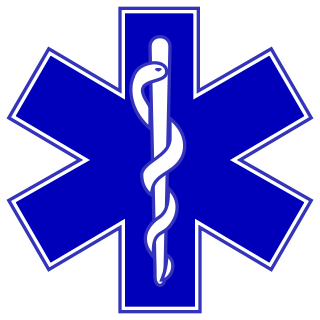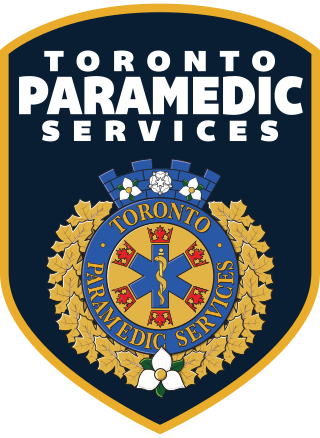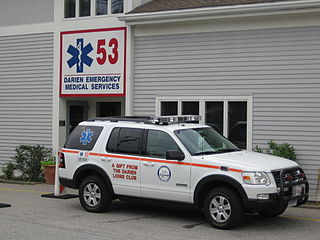
Emergency medical services (EMS), also known as ambulance services ""pre-hospital care"" or paramedic services, are emergency services that provide urgent pre-hospital treatment and stabilisation for serious illness and injuries and transport to definitive care. They may also be known as a first aid squad, FAST squad, emergency squad, ambulance squad, ambulance corps, life squad or by other initialisms such as EMAS or EMARS.

An emergency medical technician is a medical professional that provides emergency medical services. EMTs are most commonly found serving on ambulances and in fire departments in the US and Canada, as full-time and some part-time departments require their firefighters to at least be EMT certified.

A paramedic is a healthcare professional trained in the medical model, whose main role has historically been to respond to emergency calls for medical help outside of a hospital. Paramedics work as part of the emergency medical services (EMS), most often in ambulances. They also have roles in emergency medicine, primary care, transfer medicine and remote/offshore medicine. The scope of practice of a paramedic varies between countries, but generally includes autonomous decision making around the emergency care of patients.

The City of Toronto Paramedic Services is the statutory emergency medical services provider in Toronto, Ontario, Canada. The service is operated as a division of the City of Toronto, under the Community & Social Services cluster. The service is funded by the municipal tax base, and operates similarly to other municipal divisions, such as the Toronto Parks, Forestry & Recreation division, or the Toronto Water division, but retains operational independence from other divisions. While under municipal government control, it is subject to provincial legislation and licensing. It is not the only service provider in its area; private-for-profit medical transport services also provide routine, non-emergency transports and coverage for special events, but the statutory emergency medical system is the only provider permitted to service emergency calls.

A paramedic is a healthcare professional, providing pre-hospital assessment and medical care to people with acute illnesses or injuries. In Canada, the title paramedic generally refers to those who work on land ambulances or air ambulances providing paramedic services. Paramedics are increasingly being utilized in hospitals, emergency rooms, clinics and community health care services by providing care in collaboration with registered nurses, registered/licensed practical nurses and registered respiratory therapists.

The British Columbia Ambulance Service (BCAS) is an ambulance service that provides emergency medical response for the province of British Columbia, Canada. BCAS is one of the largest providers of emergency medical services in North America. The fleet consists of 658 ground ambulances operating from 183 stations across the province along with 283 non-transport support vehicles. Additionally, BCAS provides inter-facility patient transfer services in circumstances where a patient needs to be moved between health care facilities for treatment. BCAS also operates a medical evacuation program that utilizes both fixed-wing and rotary aircraft.

Emergency Health Services (EHS) is a branch of the Nova Scotia Department of Health tasked with providing emergency medical services. It is also responsible for transportation of patients between hospitals and medical facilities. At present, all ground ambulance and air ambulance service in Nova Scotia is contracted by EHS to Emergency Medical Care (EMC), a subsidiary of Medavie Health Services.
Ottawa Paramedic Service is a uniformed municipal public safety agency providing emergency and non-emergency paramedic care to residents and visitors of city of Ottawa, Ontario. It is the sole, licensed, statutory provider and is operated directly by the city. The Service is an independent third service provider. This means that it is part of the Emergency and Protective Services department of the city but functions as an independent and separate agency from other services. The Ottawa Paramedic Service operates in compliance with legislation and licensing standards overseen by the government of Ontario. It also provides routine, non-emergency transports and emergency paramedic coverage for special events. It is the only service provider permitted to service medical emergency calls in the City of Ottawa.

In the United States, emergency medical services (EMS) provide out-of-hospital acute medical care and/or transport to definitive care for those in need. They are regulated at the most basic level by the National Highway Traffic Safety Administration, which sets the minimum standards that all states' EMS providers must meet, and regulated more strictly by individual state governments, which often require higher standards from the services they oversee.
Winnipeg Fire Paramedic Service (WFPS) provides fire and EMS services to the City of Winnipeg, Manitoba. It operates from 27 fire stations, and 3 administration offices across the city.

Emergency medical services in Canada are the responsibility of each Canadian province or territory. The services, including both ambulance and paramedic services, may be provided directly by the province, contracted to a private provider, or delegated to local governments, which may, in turn, create service delivery arrangements with municipal departments, hospitals, or private providers. The approach, and the standards, vary considerably between provinces and territories.

Emergency medical personnel in the United Kingdom are people engaged in the provision of emergency medical services. This includes paramedics, emergency medical technicians and emergency care assistants. 'Paramedic' is a protected title, strictly regulated by the Health and Care Professions Council, although there is tendency for the public to use this term when referring to any member of ambulance staff.
Emergency medical services in Australia are provided by state ambulance services, which are a division of each state or territorial government, and by St John Ambulance in both Western Australia and the Northern Territory.

LifeFlight is an air ambulance critical care transport service that operates in the Canadian provinces of Nova Scotia, New Brunswick and Prince Edward Island.

Ambulance New Brunswick, also referred to as ANB, is a provincial Crown corporation administered by the Department of Health in the Canadian province of New Brunswick.

The Nova Scotia Paramedic Society (NSPS) is a professional association established in 2011 that promotes the study, research, and communication of the history of Emergency Health Services (EHS) within the province of Nova Scotia, Canada.

Ronald Daniel Stewart was a Canadian medical doctor and politician. He represented the electoral district of Cape Breton North in the Nova Scotia House of Assembly from 1993 to 1997. He was a member of the Nova Scotia Liberal Party. He played a role in the professionalization of emergency medicine in the latter half of the 20th century, being named a "Hero of Emergency Medicine" in 2008.
Emergency Medical Care Inc. (EMC) is the private company which provides all ground ambulance, medical communications, and air ambulance services in Nova Scotia, Canada. EMC is a subsidiary of Medavie Health Services and operates under contract from the Nova Scotia government's Emergency Health Services.
Thomas James MacKeough was a Canadian politician, who represented the electoral district of Cape Breton North in the Nova Scotia House of Assembly from 1960 to 1978. He was a member of the Progressive Conservatives. McKeough served in the Executive Council of Nova Scotia as Minister of Municipal Affairs, Minister of Labour, Minister of Trade and Industry, and Minister of Finance. He played a major role in reshaping EMS in Nova Scotia. Following his retirement from politics, McKeough chaired a Provincial Task Force on Occupation Health and Safety in the workplace.

Victoria General Hospital is a hospital in Halifax, Nova Scotia, Canada, and part of the Queen Elizabeth II Health Sciences Centre, which began as the City Hospital in 1859.















